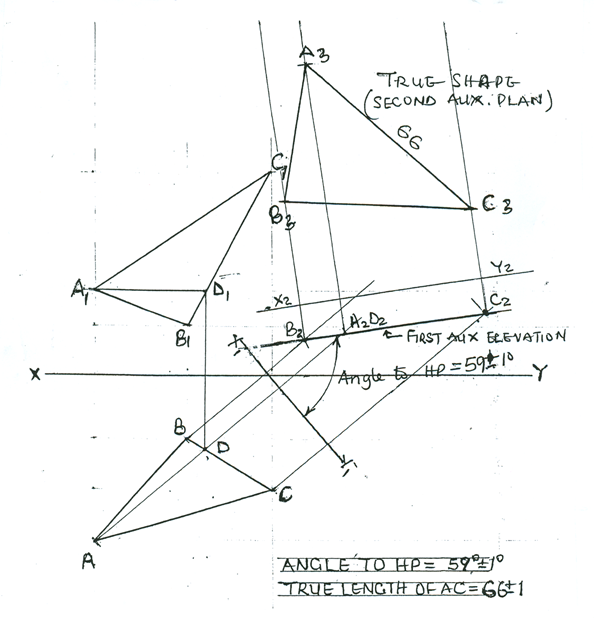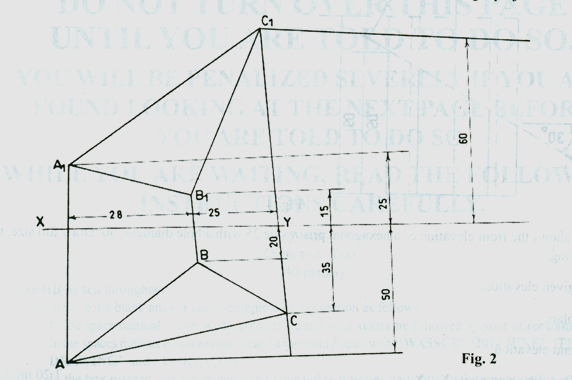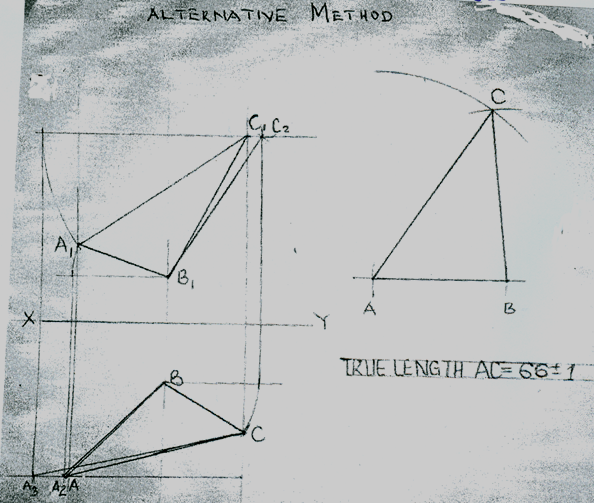
(a) Draw the true shape of the laminae.
(b) Measure and state the:
(i) angle of inclination to the horizontal plane;
(ii) true length of AC.
(c) Indicate on the drawing, the:
(i) auxiliary elevation;
(ii) auxiliary plan.
Candidates were expected to:
(a) (i) COPY THE GIVEN VIEW:
(1) draw the front elevation;
(2) draw the plan;
(3) draw the X – Y axis.
FIRST AUXILIARY ELEVATION:
(ii) (1) draw the horizontal line, A1D1 in the front elevation;
(2) project from D1 to D in the plan;
(3) join AD and extend it beyond the X – Y axis;
(4) draw parallel lines from B and C respectively to the line AD extended;
(5) draw X1Y1 axis perpendicular to AD extended;
(6) locate B2, A2D2 and C2 using X – Y as datum with the corresponding dimensions from the elevation on X1 Y1 for the first auxiliary elevation;
(7) draw the first auxiliary elevation.
(iii) TRUE SHAPE (SECOND AUXILIARY PLAN)
- draw X2Y2 axis parallel to B2 C2 ;
- locate A3, B3 and C3 use X 1 Y1 as the datum with the corresponding dimensions from the plan on X2Y2;
- join the points A3, B3 and C3 to obtain the true shape.
(b) Measure, indicate and state the:
(i) angle of inclination to the H.P = 590 ± 10 ;
(ii) true length of AC = 66 ± 1;
(c) Indicate:
(i) auxiliary elevation;
The solution is shown below:

ALTERNATIVE METHOD
TRUE SHAPE OF TRIANGULAR LAMINAE
Candidates were expected:
- (i) COPY THE GIVEN VIEWS:
- draw the front elevation;
- draw the plan;
- draw the X – Y axis.
(ii) TRUE SHAPE:
- draw to obtain the true length AB;
- draw to obtain the true length of AC;
- using the true lengths to obtain the true shape.
- (i) Measure and state:
- angle of inclination to the horizontal plane (HP) 59 ± 1;
- true length of AC = 66 ± 1.
(c ) Indicate:
- auxiliary elevation;
- auxiliary plan (true shape).
The solution is shown below:




